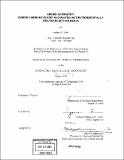Green chemistry : dense carbon dioxide and water as environmentally benign reaction media
Author(s)
Allen, Andrew J. (Andrew John), 1978-
DownloadFull printable version (5.379Mb)
Alternative title
Dense carbon dioxide and water as environmentally benign reaction media
Other Contributors
Massachusetts Institute of Technology. Dept. of Chemical Engineering.
Advisor
Jefferson W. Tester.
Terms of use
Metadata
Show full item recordAbstract
(cont.) was investigated in scCO₂, and the cycloaddition between cyclopentadiene and methyl vinyl ketone (MVK) was studied in an scCO₂/liquid water environment. Nitrogen chemistry, specifically the synthesis of nitrogen heterocycles from amines, was also studied in scCO₂ and scCO₂/liquid water systems. The objective of studying the Diels-Alder cycloaddition of 9-hydroxymethylanthracene with N-ethylmaleimide in scCO₂ was to demonstrate the ability of scCO₂ to dramatically accelerate the rate of this reaction when compared to conventional solvents. Using spectroscopy to track the disappearance of the 9-hydroxymethylanthracene peak, it was found that this reaction proceeds at rates in scCO₂ that are significantly faster than in traditional organic solvents. It was also observed that the reaction rate constant increased with decreasing density, opposite the trend normally observed for most reactions conducted in scCO₂. On the basis of the low solubility of 9-hydroxymethylanthracene in scCO₂ and similar results observed in fluorocarbon solvents (fluorocarbons and scCO₂ are known to behave similarly as solvents), a solvophobic mechanism was inferred as the cause of the rate acceleration observed for this particular reaction in scCO₂. In order to utilize the complementary solvation powers of scCO₂ and water, a second Diels-Alder reaction, cyclopentadiene with MVK, was studied in an scCO₂/liquid water mixture. Specifically, the effect of MVK concentration on the selectivity and conversion was studied under both silent and sonicated conditions ... With an ever increasing focus on reducing the environmental impact of solvent releases on human health and the environment, the replacement of conventional, organic solvents with alternative compounds that are inherently benign has attracted much attention in both industry and academia. Supercritical carbon dioxide (scCO₂) and water are two alternative compounds that are of particular interest because they are non-toxic, non-flammable, readily available, and cheap. Although scCO₂ has been successfully used in industry as a solvent for selective extraction (e.g. extraction of caffeine from coffee beans), development of scCO₂ as a reaction solvent has been less successful due to its limited solvation power for many organic reagents of interest. In addition scCO₂ has generally been shown to reduce both the reaction rate and selectivity of many reactions when compared to conventional solvents. Unlike scCO₂, water is known to significantly accelerate reaction rates and improve selectivities over that obtainable in conventional solvents. However, most organic compounds are insoluble in water which has limited its use as a reaction solvent for industrial-scale processes. In order to replace conventional solvents with scCO₂ and/or water, significant technological advantages resulting from the use of these compounds will have to be demonstrated. This research attempts to demonstrate some potential advantages of using scCO₂ and scCO₂/water as reaction media for several synthetic transformations of interest. The Diels-Alder cycloaddition of 9-hydroxymethylanthracene and N-ethylmaleimide
Description
Thesis (S.M.)--Massachusetts Institute of Technology, Dept. of Chemical Engineering, 2004. Includes bibliographical references.
Date issued
2004Department
Massachusetts Institute of Technology. Department of Chemical EngineeringPublisher
Massachusetts Institute of Technology
Keywords
Chemical Engineering.